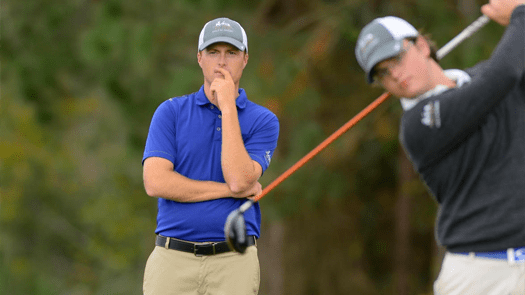The playing lesson has been around a long time, but new and more effective ways of conducting these on-course sessions are emerging.
Golf is the only sport that isn’t routinely taught on its “field of play.” That’s why you can Google the phrase “can’t take my driving range swing to the course” and find pages of articles addressing the problem. Of course, 90-shooters who moan about this usually fail to track how many lousy shots they produce in a range session, but they’re still right that ball-hitting on-course can seem dramatically different from hitting on-range.
In general, the emphasis on coaching “situationally” is growing. Leading lights such as Lynn Marriott and Pia Nilsson are gradually leaving the range behind, shifting their focus to on-course work as a standard procedure with every student.
Pinehurst Learning Center students get whatever customized form of on-course work will help them the most. “We may have them hit a drive, hit an approach shot, then U-turn back to the tee to try those two shots again, with a different thought and different strategy,” says academy director Eric Alpenfels. “We might go to various trouble areas and drop several balls at a time.” And if a player “gets hot,” just continuing on, in the zone and encouraged by their instructor, might be the best coaching they ever received.
At Monarch Beach Resort in the California town of Dana Point, award-winning teacher Glenn Deck will sometimes begin a playing lesson with 20 minutes on the range. The idea is to get a baseline for where the golfer and their mechanics are at that particular moment, before heading out. After the range phase is over, Glenn’s rule of “no mechanics on the course” takes effect.
“The idea is to find optimal ways to teach the student how to play the game,” Deck says. “Which side of the tee box do they start from? Do they know how to calculate yardage so it accounts for all factors? Do they know where they can miss and where not to miss? Are they trying to hit their career shot every time? Can they control distance on high-lofted clubs? There’s a whole separate assessment to go through,” he says, “The price they pay for that amount of time is considerable ($600 for 3.5 hours, including the range time), but the level of detail we get into is deep. It covers a whole lot of ground.”
Colorado-based Dan Sniffen has learned the value of on-course instruction as a retention tool. If a 10-lesson series has gone well but is approaching its endpoint with no on-course work having occurred, heading out to the fairways is a great tool for refocusing the student and restating the value of long-term coaching.
“Going on the course is a good refresher for the relationship, and it can bring the student back to that sense they had at the beginning of wanting to really accomplish something,” Sniffen believes. He will use the playing lesson to produce a simplified Strokes Gained worksheet, showing where the player can genuinely lower their score and what sort of practice and coaching is appropriate going forward to do so. “That approach generally leads to a renewal,” says Dan.
Are you getting some static from the golf shop about playing lessons? Veteran coach Bill Davis has always handled that issue by repeating what George Fazio told him: Growing the game means teaching most effectively, so that golfers play better—which means you need to take them on the course. The result is they will play more often and spend more money at the facility.
If you’re reading this, you’ve set a goal to run your teaching business more effectively and profitably. CLICK HERE to learn about Instructor Plus, a new service that’s helping coaches solve business problems and succeed as never before.


